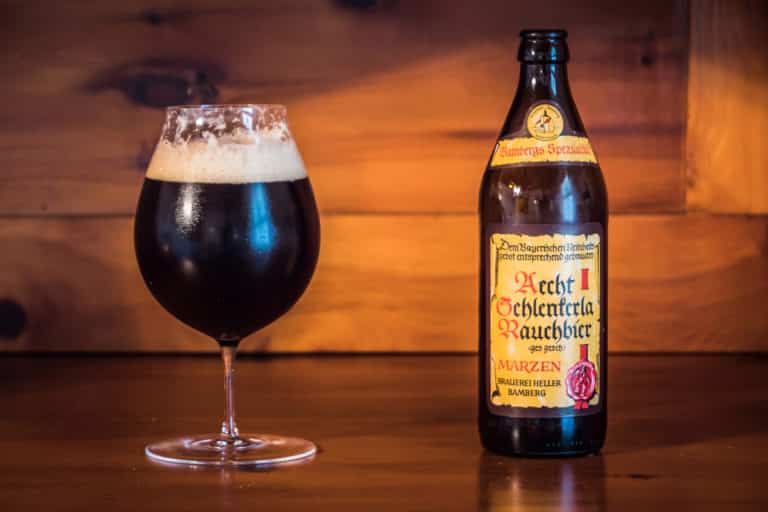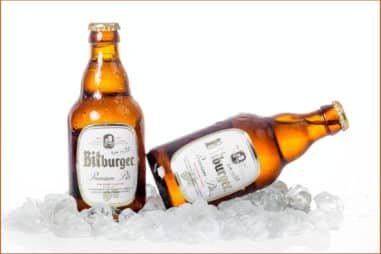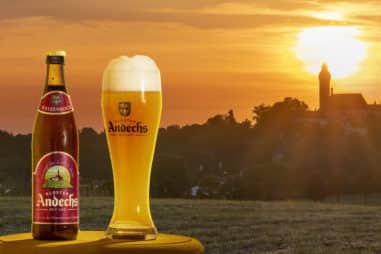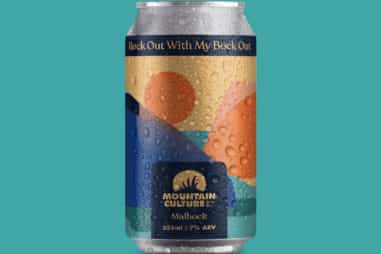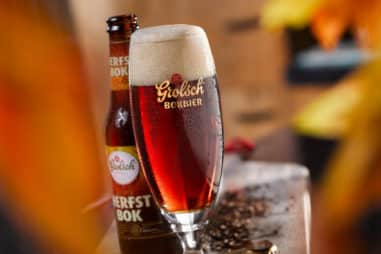If it’s your first time hearing about a Rauchbier, it’s actually not that surprising. Only two breweries today make a traditional Rauchbier.
Smoke beer? What exactly is it? And how does it taste?
Believe it or not, the German Rauchbier style dates back hundreds of years back. And with a style this old, where can you find an authentic brew of it?
Well, you’re about to find out.
What Type of Beer Is Rauchbier?
A Rauchbier is a German-style lager that uses smoked malt as a key ingredient to bring a smoky essence to the beer.
However, it’s not so much as simply sourcing smoked malt. It’s the process of how the malt is kilned.
Back in the day, smoked beer was quite common. How so? Before the use of any equipment, you had to dry malt over an open fire. In fact, this was the only way possible.
Because of this process, you ended up with malt or grains that had a dark color. In addition, the beer would have a smoky essence or taste due to how the malt was kilned.
What about the yeast, you might ask?
When malt is kilned directly over an open flame, it also crystallizes the sugars in your malt. In effect, there isn’t a lot of sugar for yeast to ferment.
Is Rauchbier an Ale or Lager?
A Rauchbier is a lager, not an ale brewed with malts that were dried on an open flame. This gives a Rauchbier its definitive smoky flavor character. It’s also mostly a medium-strength lager and is closely similar to a Märzen.
What Does Rauchbier Taste Like?
The taste of a Rauchbier strikes a balance of malt and smoke. Although the balance can vary, both should complement each other.
Flavor-wise, a Rauchbier has a lightly toasted and rich malty flavor profile similar to a Marzen.
The maltiness can be sweet but it should finish off dry or semidry. As for the smoky character, you’ll mostly taste ham- or bacon-like notes. However, the smokiness of a Rauchbier shouldn’t be greasy.
Hop bitterness is medium with an IBU of 20 to 30 with low hop flavors & aromas of herbal, floral, or spicy. It’s also important to note that a Rauchbier should have a clean lager fermentation character.
Finally, any burnt, harsh, sulfury, charred, or phenolic smoky notes are unacceptable in a Rauchbier.
Why Does a Rauchbier Have a Smoky Flavor?
A Rauchbier has a smoky flavor not solely because of the malt or grains used. Rather, it’s how brewers kiln the malt that delivers the final smoky aspect of the beer.
Now, you might be wondering…
Does that mean all the beer at the time had the same smoky flavor? Not quite. Because what influenced the flavor of the malt wasn’t just the open fire itself, but several factors like:
- How long the malts were kilned.
- The fuel used during the kilning process.
- The temperature at which you kilned malt.
Leaving the malt exposed to an open flame for too long can obviously lead to crystallizing most of the sugar. If not all of the sugar. The end result wouldn’t be beneficial for the fermentation process.
The temperature was also tricky to control. With an open flame, you can’t control the ‘degrees’ at which your malts are kilning.
And finally, the fuel. There were 3 types of fuel used for kilning:
- Coal: Least favorable fuel because it was expensive and dirty. You’d end up with less-than-desirable flavors in your beer.
- Straw: Sometimes used as a fuel source and more favorable than coal.
- Wood: Imparts a variety of flavors since there are also several varieties of wood like oak wood, for example.
However, the fuel brewers would use at the time mostly depended on the area they lived in.
If there was no wood or straw available, they’d have to use coal. For German brewers though, they stuck to using wood as their main fuel source.
Today, wood is still used as the most favorable fuel source for kilning malt. Beechwood is another common wood variety used.
Is a Rauchbier Brewed the Same Way Today?
You’ll find that the Rauchbier of today is still brewed over an open flame, just as how it was before.
So, what makes the Rauchbier of today different from the Rauchbier of before?
It’s simple.
Brewers today have more access to resources and equipment to control crucial factors when kilning malt.
The process is still tricky, of course. Being able to slowly raise the temperature of the flame and control how much wood or when to add wood are all tricky variables.
Then again, you have a larger scale of wood varieties to use when kilning malt, such as:
- Citrus wood
- Pecan wood
- Oak wood
- Alder wood
- Mesquite wood
- Applewood
Citrus wood has a similar smoky character to beach wood, while pecan wood adds a great nutty flavor if that’s what you prefer.
Although mesquite wood is one available variety, its flavor can overwhelm the flavors of your beer.
If you’ve ever tried an Alaskan Smoked Porter, it uses alder wood to add a flavor that reminds most of salmon. Finally, oak and applewood are also great wood varieties; however, pecan wood adds a smoother flavor to your beer.
How to Pronounce Rauchbier
The American pronunciation for Rauchbier is “rowk · beer”. However, since this is of a German origin, Rauchbier will sound differently with a German accent.
In German, pronouncing “ch” depends on the preceding letter or if “ch” starts at the beginning of a word. If the “ch” comes after vowels like “i” and “e”, it’s pronounced as a soft English “sh.”
For vowels like “o”, “a”, and “u”, the pronunciation shifts to a “ch” that sounds more like a Scottish loch. This sound is similar to the noise someone would make when they clear their throat.
So, for “Rauchbier,” since the “ch” comes after the vowel “u” it shouldn’t be pronounced as “rowk · beer” in German. Rather, the “rauch” should have the Scottish loch pronunciation instead of “rowk” or “raush.”
How Do You Serve Rauchbier?
A Rauchbier is best served using a Dimpled Mug, Vase, or Willi Becher. The ideal serving temp should be around 50°F to 55°F (10°C to 12.8°C). If you plan to store a German Rauchbier in a cellar, you can do so as long as it’s away from light.
It’s also worth noting that German Rauchbiers age well thanks to their smoky character. The shelf life of a Rauchbier should last a couple of years. Some say it tastes best after 2 years of aging. However, some have tried a Rauchbier that’s aged longer than 2 years and still tasted great.
What to Pair With Rauchbier
You could try and pair a Rauchbier with smoked meats but that might be too overwhelming or lead to a clash of flavors. After all, smoke on smoke might be too heavy for some.
But if you love a deep smoke profile whether it’s in beer or food, give it a try. If you want a better food pairing that balances the smokiness of a Rauchbier, go for any grilled meat.
Any meat that’s grilled makes for a great balance for a Rauchbier’s smoky character. And even if grilling your meat produces some smoke, it’s not heavy to the degree that it’d clash with your Rauchbier’s flavor.
When it comes to grilled meat, bratwursts seem like the obvious choice. And there’s no doubt a bratwurst makes an excellent food pair. But don’t limit yourself to these. You can also go for grilled fish, pork ribs, steak, and chicken.
Some bacon and grilled asparagus would be nice. Even Portobello mushrooms would do the trick. Now, if you’re not feeling too excited about food that’s cooked on the grill, don’t worry.
Other rich meaty dishes like beef stews or roasts whether it’s pork, chicken, or beef make great food pairings. Throw in high-umami ingredients like tomatoes, anchovies, potatoes, and olives to heighten up your taste buds.
And finally, you can’t ever go wrong with cheese. Not just any cheese, of course. Think strong or aged cheese with hints of smoke, like:
- Gouda
- Aged cheddar
- Parmesan
- Monterey Jack
How to Brew Rauchbier
For starters, don’t use liquid smoke if this is your first time brewing a German Rauchbier. You might see other homebrewers have their success on several forums, but the main problem with liquid smoke is…
It simply doesn’t taste as good. Put simply, you’ll still be able to brew a German Rauchbier. But don’t expect it to have the same taste as a smoked malt. After all, just because a beer is drinkable, doesn’t mean you’d drink it willingly.
How to Choose the Right Malt for a Rauchbier
So, how do you get the right smoky character in a German Rauchbier? By choosing the best smoked malts, of course. And 3 of the best malts for a German Rauchbier’s smokiness include:
- Malz Rauch malt
- Briess Cherrywood smoked malt
- Weyermann Beechwood smoked malt
Some might also suggest trying peat-smoked malt, but please don’t. It can easily ruin your Rauchbier’s flavor profile and turn it into a harsh and unpleasant lager. Now, if you’re deeply curious to try peat-smoked malt, add very light amounts only.
Generally, peat-smoked malts are better for say, a smoked porter or Scotch ale. But in a German Rauchbier? It’s a hard slap to your face if you use it and find that your Rauchbier is…well, ruined.
Aside from your smoked malts, you can also add melanoidin malt to bump up your Rauchbier’s bready flavor. Black Patent malt is another option if you want to add more color or roastiness to balance the sweetness of smoked malts.
Other malts to add include the following:
- Vienna malt
- 2-row malt
- Munich malt
- CaraPils malt
- Lager malt
- Pilsner malt
If you want a lot of smoke character in your Rauchbier, adding 10 lbs. (4.5 kg) of Cherrywood smoked malt is sufficient. However, some recipes online don’t go higher than 4 lbs. (1.8 kg) of smoked malt. For example, you’ll see recipes using 3.5 to 4.5 lbs. (1.6 to 2 kg) of smoked malt.
To tell you the truth, that’s because it depends on which smoked malt you use.
For example, using a Weyermann’s beechwood smoked malt is more forgiving. In addition, it’s easier to use if it’s your first time. For a Weyermann’s, using 50% to 70% in your total grain bill should be fine without adding unwanted greasy flavors.
Malz Rauch malt has a bold and pleasant smoke character that’s even stronger than Weyermann’s. In fact, it’s probably the best smoked malt you could use when homebrewing a Rauchbier. However, due to its high smoke intensity, 20% to 30% is a good starting point.
And finally, the Briess Cherrywood smoked malt has the heaviest smoke experience. Due to this and its acrid finish, it’s best to use 20% to 25% of Cherrywood smoked malt in your grain bill.
The rest of the grain bill varies from here on out.
Some use lager or Pilsner malt as the base malt while others stick to 2-row malt. Apart from Munich and Vienna malt, some homebrewers even add roasted barley.
Nevertheless, Vienna malt adds good toastiness to your Rauchbier. And Munich malt bumps up the color and complexity of your beer.
Take note, though. It’s completely up to you how much smokiness and maltiness you want in your Rauchbier. Just remember that these two should be balanced or rather, both should complement each other.
Can You Smoke Your Own Malts?
You can smoke your own malts if you want, and it also gives you more wood variety flavors to try. Applewood, pecan, cherry, and citrus wood are great options.
Preferably, smoke your malts using a smoker, and not a conventional grill. Why? Because it’s harder to control and maintain the temperature with a grill. After all, proper temperature control is crucial in smoking your malts.
If you decide to smoke your own malts at home, remember these tips:
- Keep your malts moist using chlorine-free water.
- Your malts should be moistened periodically throughout the smoking process.
- It’s better to use light malt when smoking since a lighter malt makes the smokiness more pronounced.
- Use a spray bottle for moistening your malts. You don’t want your malts to be too wet.
- A fine mesh bag is ideal for preventing any ashy flavor in your grains.
- Avoid glowing coal and flames since these scorch your malt.
- Smoke your malts for 4 hours at a temperature of 120°F (49°C).
After smoking your malts, if you’re not going to use them yet, make sure they’re dry before storing them. Then, a day or two before brewing your Rauchbier, you can steep a small amount of the malt in hot water. It’s similar to steeping hot tea.
Now, why do this? Mainly so you can get an idea of the grain flavor that will contribute to your beer.
What Hops to Use in Brewing a Rauchbier?
You can add any German noble hop variety, but from personal experience, some of the best for a German Rauchbier are:
- Perle
- Tettnang
- Hallertauer
- Hallertau Hersrbucker (if you don’t have Hallertauer)
Add your hops either with 90 minutes or 60 minutes left in the boil. This should give you a good IBU of 25, which is perfect for a German Rauchbier.
You can also do a second hop addition with 30 minutes or 5 minutes left in the boil. Some might even do aroma hopping. At flameout, you can add 1 oz. (28.4 g) of your hops to get a good floral or spicy aroma that pairs well with your Rauchbier’s smokiness.
What Yeast is Best for Brewing a Rauchbier?
Any German lager yeast strain works well when brewing a Rauchbier. However, there are 2 yeast strains worth noting for a German Rauchbier, such as:
- Fermentis S-23 Saflager
- Munich Lager (Wyeast 2308)
How Long to Ferment Rauchbier?
Fermenting a Rauchbier should take between 3 to 4 weeks. Pitch your yeast at a temperature between 48°F (8.9°C) to 52°F (11°C).
A safe starting temperature if it’s your first time is to pitch at 50°F (10°C). Then, let the temperature rise to 60°F (15.6°C) slowly over the next two weeks.
How to Lager a German Rauchbier
After primary fermentation, you can opt for secondary fermentation at a cooler temperature – about 45°F (7°C). Once your beer has fermented, you can lager for about 6 weeks at 38°F (3°C).
Take note. The longer you lager your beer, the smoother the flavor of your beer.
Can You Age a Rauchbier?
As long as there isn’t any excess oxidation, a Rauchbier ages well. As German Rauchbier ages, the bitterness of the hops fades and the malt profile becomes more pronounced. In other words, aging should make your Rauchbier even smokier.
Generally, a year of aging should bring out a lot of smokiness from the malt in your Rauchbier. After that, it depends on how the beer is stored.
If it’s stored in colder temperatures, it should preserve the flavors longer. Either way, a German Rauchbier is one of the few beers you can definitely age and expect to taste great.
But what happens if oxygen manages to creep into your Rauchbier and it oxidizes?
The first and probably the biggest quality difference you’ll notice is the loss of malt flavor, followed by a weaker smokiness.
Who Makes Rauchbier?
There are 2 breweries today that still brew a traditional Rauchbier:
- Brauerei Schlenkerla
- Christian Merz Brauerei Spezial
Between the 2 breweries, Brauerei Schlenkerla is much older, stretching all the way back to 1387. Christian Merz Brauerei Spezial’s origins date back to 1536.
To this day, both breweries still process and kiln their own malt – just like how it was done hundreds of years ago. Brauerei Schlenkerla uses beechwood for their Rauchbier and oak wood for their Christmas double Bock.
One of the most popular beers offered by Brauerei Schlenkerla is Aecht Schlenkerla Rauchbier.
What’s also interesting is Schlenkerla’s Helles lager. It has a slight smokiness to it, but smoked malts weren’t used in the brew. Instead, the yeast used to brew the Aecht Schlenkerla Rauchbier is repitched into the Helles lager and imparts a smoky & light rauch note.
As for Christian Merz Brauerei Spezial, the brewery also offers a Rauchbier – several actually. The German brewery is also well-known for its Marzen-style lager and Weissbier.
Where Is Rauchbier Brewed?
Rauchbier is brewed in the Franconian city of Bamberg, Germany.
The 2 breweries have been brewing Rauchbiers for over a century. In fact, these breweries saw no need to change the traditional style of kilning malt with wood.
Where Can I Buy Rauchbier?
You can buy a Rauchbier on several online platforms today, such as:
- Drizly
- Totalwine
- Beermenus
- Halftimebeverage
- BeersofEurope
If you check what others have to say on Untappd, most of the locations you’ll see are in Germany.
However, there was one place located in Elmhurst, Illinois that one person mentioned they were able to buy in. And that place is Beerhead Bar.
That aside, the good thing about buying a Rauchbier online is you don’t have to worry as much about its shelf life since Rauchbiers age well.
But there’s really no better place than getting it in Bamberg, Germany.
Where to Buy Aecht Schlenkerla Rauchbier
You can buy an Aecht Schelnkerla Rauchbier on the same online platforms mentioned above. After all, Aecht Schlenkerla is a widely popular Rauchbier.
Even if it’s not readily available as other beers, it’s bound to be in stock in various online shops. Last but not least, it’s worth trying Schlenkerla’s official website. You can even buy a 10-box or 20-box of Aecht Schlenkerla Rauchbier on their site.

